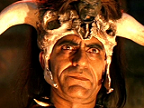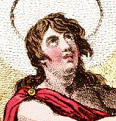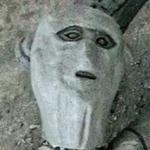|
Fox Ironic posted:Them's fighting words. You and what army?
|
|
|
|

|
| # ? May 25, 2024 01:17 |
|
Monarcho-communism?
|
|
|
|
FadingChord posted:Monarcho-communism? Kim Jongism
|
|
|
|
Lord Cyrahzax posted:Kim Jongism Anarcho-Juche
|
|
|
Lord Cyrahzax posted:Kim Jongism Okay it's decided, Gothia is going Juche when we get to the HOI era.
|
|
|
|
|
Randarkman posted:Jesus, anarchism is dumb, especially that there seems to be a subtype of anarchism for every conceivable ideology and belief that can be imagined. 
|
|
|
|
AJ_Impy posted:You and what army?
|
|
|
|
Gantolandon posted:There's one vanilla Vicky political system no one has tried yet... I support this option, but only because Carthage must be destroyed.
|
|
|
|
Randarkman posted:Anarcho-Juche I did a google search after you posted this... there are a lot of brain cells I'm never getting back.
|
|
|
|
Anarcho-anarchism
|
|
|
|
Conclave is on the 2nd apparently and also seems like the craziest expansion since like, Old Gods.
|
|
|
|
Chapter 35: On the Cusp of the Crusades in 1091 1091 State of the World 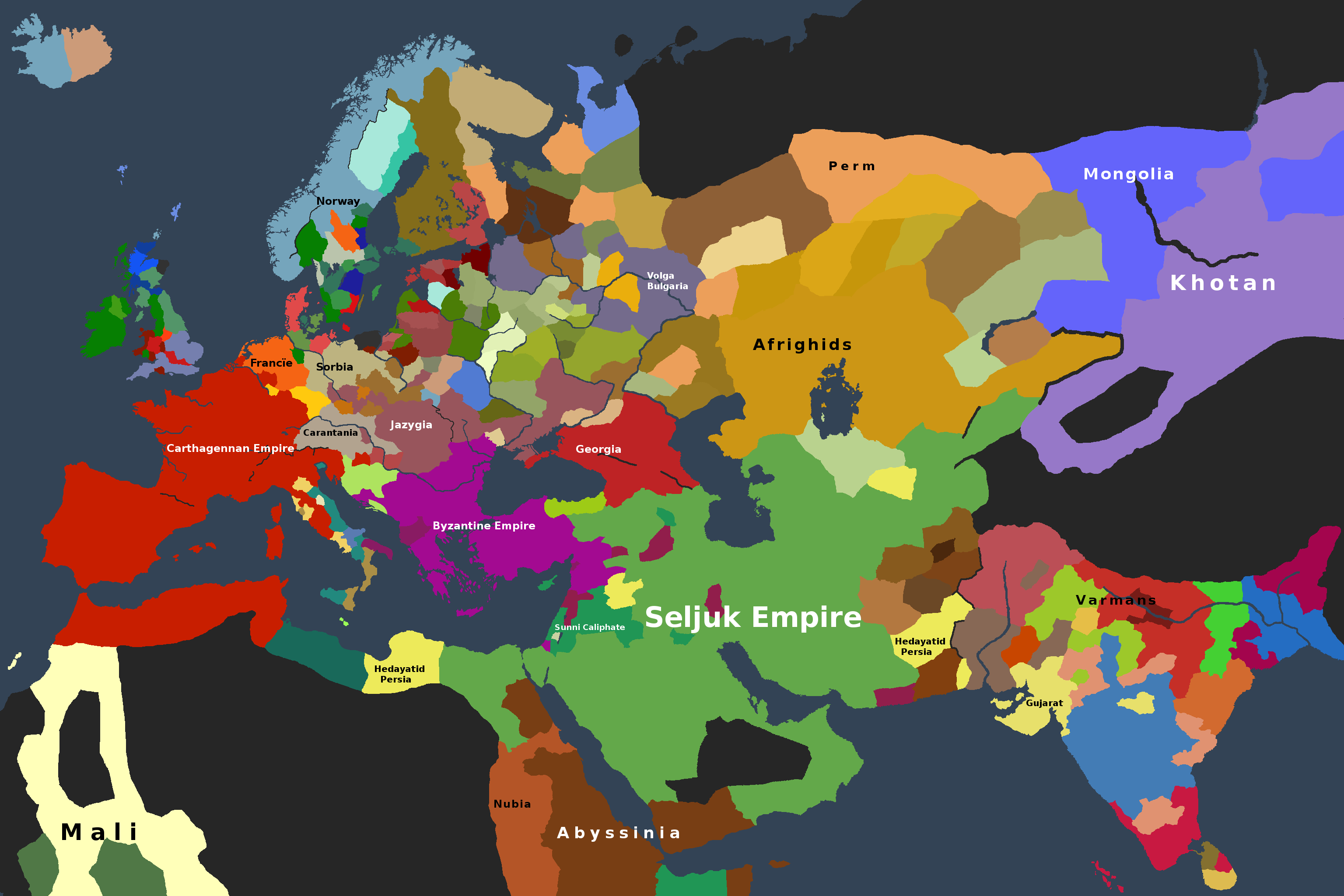 In a few superficial ways, Europe in the late 11th century still carried on the traditions of Antiquity, but socially and politically there lay a vast gulf between Medieval Europe and Classical Europe. Christianity, which had once nearly been the faith solely of the old Roman Empire, now spread itself well beyond those ancient confines. New cultures were forming, taking their cues from the Christian faith and the Roman world even when they remained Germanic, Slavic or Celtic in character. Even as the successors to the old Western and Eastern empires revitalized, reformed and grew outwards, the Roman world's culture and faith was outpacing the expansion of the empires' own borders; no matter how great the Roman realms grew, they could no longer claim sole ownership of Rome's legacy. 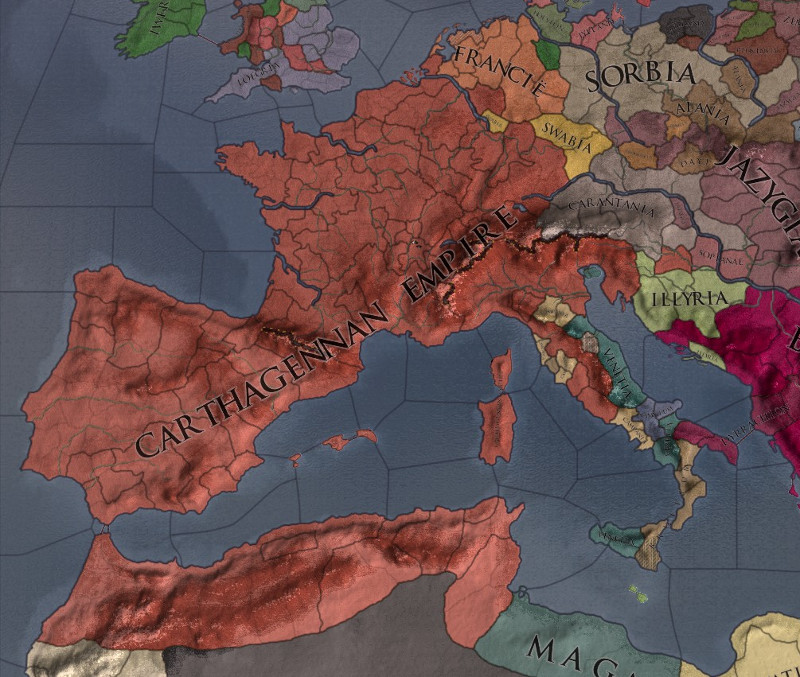 The Carthagennan Empire, heir to the Western Romans, played a central part in this transformation. Over the later part of the 1st millennium, Roman Hispania underwent enormous changes. In the 5th century, the Western Roman Empire had been reduced to holdings along the Spanish Littoral and Western Meditteranean islands. By the 8th century, the imperial remnant had recentered itself in Carthago Nova ('Carthagenna' in the vulgar dialect, hence the name) and taken on a stronger Spanish character. In the 9th century, it completed its recovery of Hispania proper, and began incorporating lands in southern Gaul and northern Africa. The 10th century saw the Goths in Gaul become increasingly involved in Carthagennan affairs, culminating in the union of the empire with Gothia in 969, and with that union came the return of Gaul to the imperial fold. With the 11th century, both Gothic and Hispanian administrators struggled to reconcile the structure of imperial government with the continuing expansion of the empire, and broadly accepted elements of feudalism as the answer. So much had changed, with the growing Gothic character of the empire and the feudalization of administration, that some historians argue that the 'Carthagennan Empire' appellation should be used for the Western Roman Empire only in the Early Middle Ages, and that it would be appropriate to call the empire in the High Middle Ages some variation on the 'Liyunesan Empire', after the Gothic capital in Gaul. 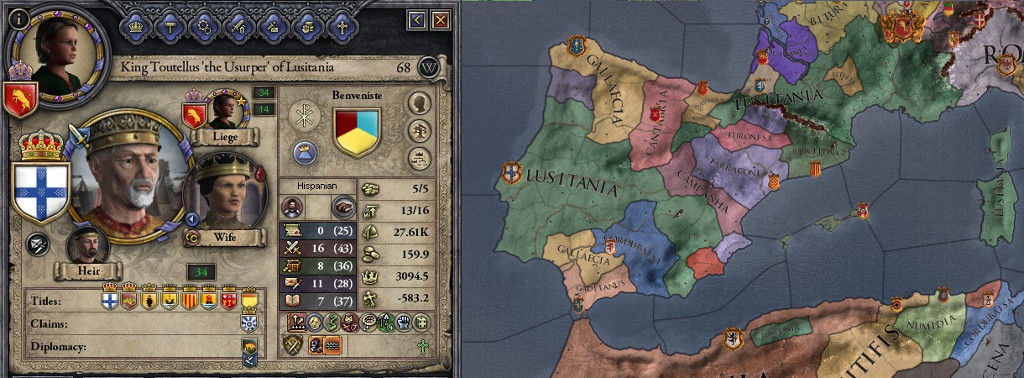 King Toutellus and his realm, as a vassal within the Carthagennan Empire. Carthagenna's strongest vassals were the foremost beneficiaries of the realm's feudalization. The ability to reliably retain lands after a ruler's death and the chance to come into more lands through claims and inheritance, rather than relying on an emperor's whims for the chance to stay in power, seriously strengthened the position of the empire's largest magnates, and lead to several major blocs coalescing fairly quickly as feudalization was underway. Foremost among these powerful new feudal vassals was the Kingdom of Lusitania. Ruled by the Benveniste dynasty, a family with Sephardic Jewish origins, Lusitania experienced a profound burst of growth in the late 11th century, culminating with King Toutellus Benveniste's claim on and conquest of Septimania in 1081. When the Kingdom of Tarraco was ended in 1083 by imperial decree, this left Lusitania as the largest power in Hispania and, indeed, the largest single realm within the Carthagennan Empire as a whole. Lusitania was the largest beneficiary of the change in the imperial constitution, but it was not the only one. The kingdom of Gallaecia, previously an imperial diocese ruled by an emperor-appointed vicar, also expanded during this period, taking over the old region of Hispalensis to Lusitania's south. Mauretania, in North Africa, consolidated its rule and began eyeing provinces elsewhere within the empire as potential routes of expansion. These and most of the other feudalizing vassals of the Carthagennan Empire during this time began working out their own schemes for power and prestige, threatening to engulf the empire in minor internal wars. 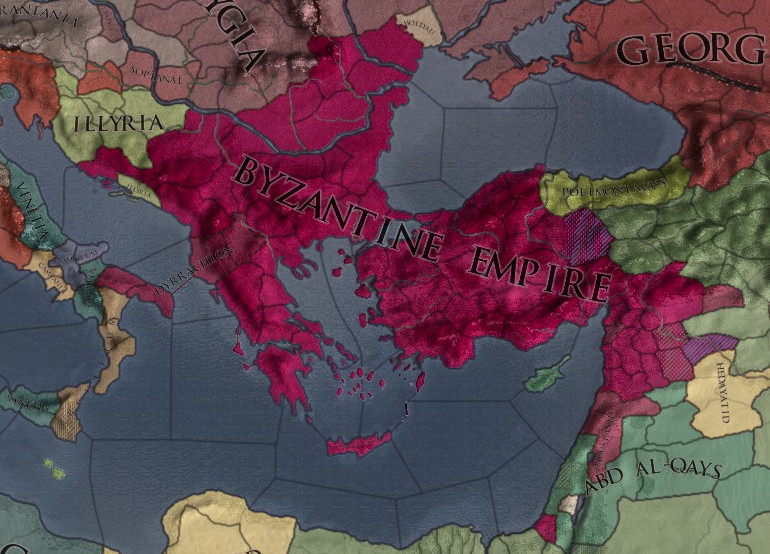 The Byzantine Empire's history up to that time was just as dynamic as Carthagenna's. The Eastern Roman Empire had nearly been extinguished in the 5th century with the great Sassanid conquests of the Levant and Anatolia. Slavic tribes in the north were increasingly tapped for manpower and support as lands east of the Bosporus were lost, and soon became integral parts of the Byzantine imperial structure. Persian pressure on the Byzantines finally abated in the 7th century with the rise of Islam in Arabia, but the Arabs in turn created new problems for the Eastern Romans, culminating with the overthrow of Muslim-friendly Emperor Heraclius by his more zealously Christian (and Slavic) foederati, who then placed one of their own on the imperial throne. Under Slavic dominance, the Byzantine Empire first stabilized, and then gradually began expanding outwards once more. By the 11th century it had retaken lands in Anatolia, Syria and even won a bastion in southern Italy, but these were now under threat from internal unrest and the rise of the Seljuks to the east. 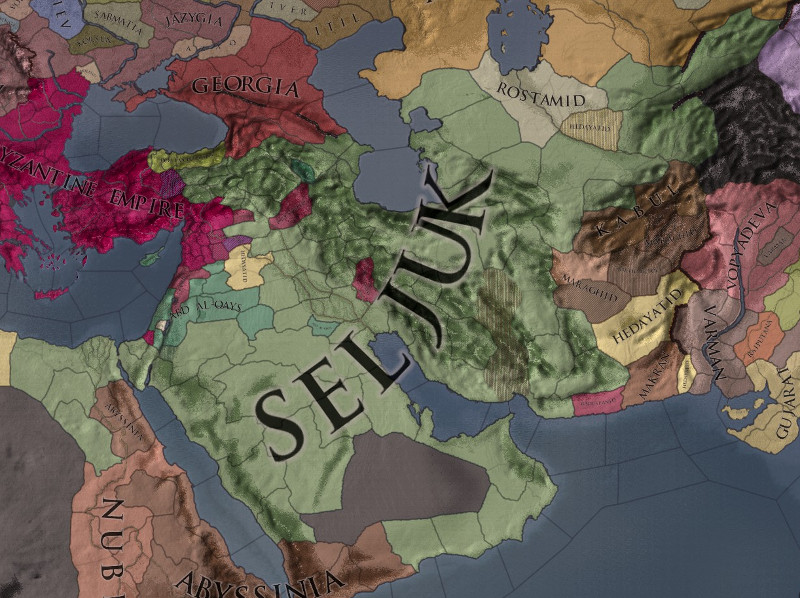 The Seljuks themselves were a new force on the scene. After Seljuk the Manichee established the Turkish realm on top of the ashes of Zoroastrian Persia, his successors all sought to emulate his legacy by further expanding the empire by conquest. Although the Turks had enjoyed victory over the Persians and Arabs both, by 1090s they were beginning to feel the same administrative strains which had shaken the Carthagennan Empire into reform. Padishah Inal Seljuk expressed little concern; in 1086 his father had begun an invasion of Byzantine-held Pontus, and Inal was on the cusp of victory against the Slavs by 1091. Administrative concerns about expansion and rulership in new provinces was something he left to his Persian court mandarins; Padishah Inal's role, in his view, was to lead his victorious troops himself, and bathe his dynasty in the brilliance and prestige of his enlightened rule. 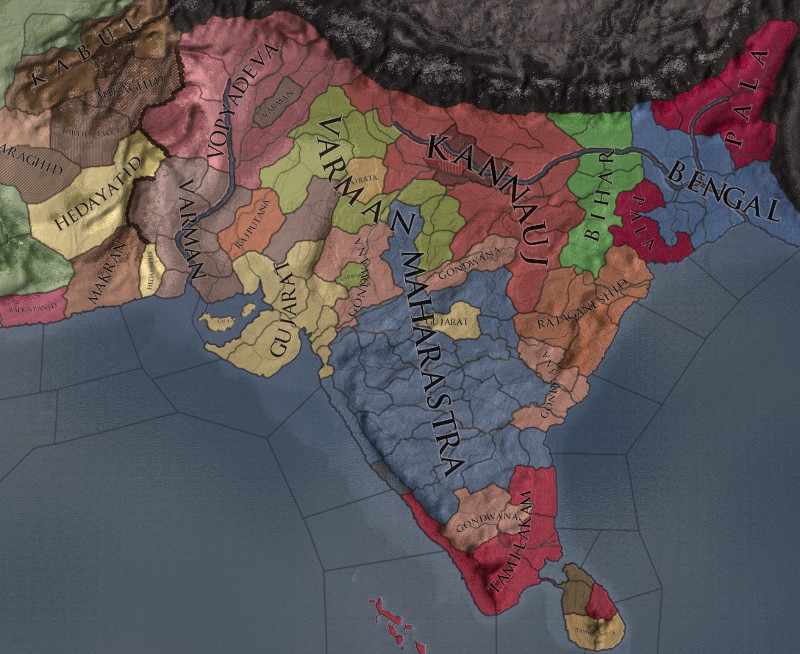 Turkish splendor and success was matched with defeat and decay further east. India and neighboring Baluchistan were home to the shattered remains of two old empires; in Baluchistan, one of the remnants of the Zoroastrian Hedayatid Empire huddled among the mountains, while the Varman dynasty, split between the kingdoms of Delhi and Kannauj, attempted to reclaim the glory of the old Gupta Empire, even as the dynasty fought itself and struggled to maintain control over its tributaries. To the south, the Rashtrakuta dynasty maintained a far more unified rule over Maharastra, and maintained a respectable court for itself in Bidar.  The one neighbor of the Seljuks who had not yet suffered tremendous defeat at their hands was Abyssinia, to the Seljuks' south. Originally a Christian realm, the ruling Solomonid dynasty had converted to Islam in the 980s under King Iyasu, only to then be conquered by the neighboring Modharite Sultanate. After a short interregnum under Arab rule, Getachew Solomonid reclaimed Abyssinia in 998, and thereafter the realm returned to Muslim Ethiopian rule. Perhaps the most remarkable ruler of Abyssinia during this period was Uways Solomonid. As a young child he had spent much time in the company of Arabs, and this exposure Arabized the Ethiopian far more than it ever did to any of his relatives. That break in culture gave Uways a certain cosmopolitan outlook lacking in his predecessors' reigns, and encouraged him to be much more tolerant than many of his contemporaries. An ardent Mutazilite, Uways sympathized with and encouraged toleration of both Christians and Jews in Abyssinia, and perhaps unsurprisingly maintained good relations with neighboring Christian Nubia as a result. Fearing Turkish aggression and worried about a possible Manichee takeover of Jerusalem, Uways sent out feelers not just to Nubia and the Caliph, but also to the Roman realms. By the account of St. Canutus, Uways allegedly invited both the Carthagennan and Byzantine emperors to join him in a “League of Abraham” to push the Turks out of the Orient altogether and establish a “Domain of God” in its place. While it is unlikely that such an offer was ever sent, given later developments it certainly seems likely that the Christian rulers of Europe were beginning to care more about affairs in the Levant.   The two Romes were not alone in their opposition to the Seljuks and concern about the Holy Lands. Much of Europe by the 11th century was thoroughly Christianized, with only minor pockets of paganry still carrying on along the European periphery and some isolated communities. Some of these Christian nations came over straight from heathenry themselves, such as Sorbia and Jazygia, while others had converted from older forms of Christianity when they came into the Roman Christian fold, as was the case with the Goths and Franks. 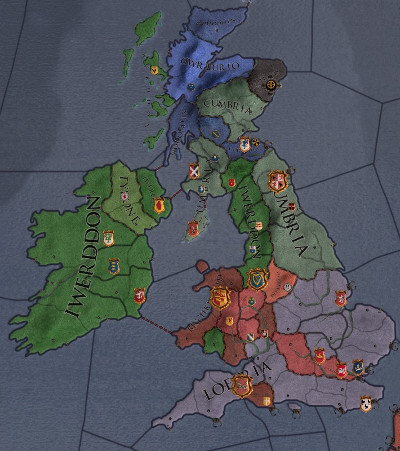 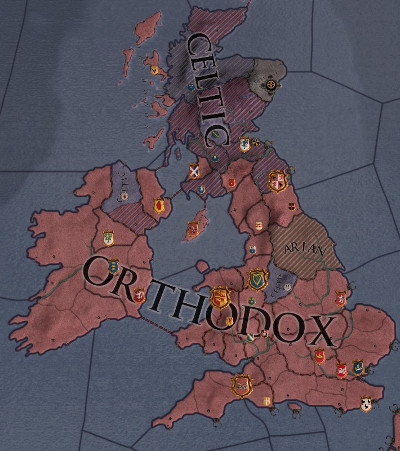 Britain was a special case, having first been split between Orthodox and Arian Christians prior to a three-century period of Celtic Pagan dominance. The Celts, ruling over a population that still carried on Arian practices in a few provinces, then converted to Orthodoxy in the mid-11th century. Compounding what was already then a complicated situation, the old Christian communities of Ireland had, under pagan apathy and neglect, drifted into heretical Donatism before being brought back to Orthodoxy by the Celtic converts. This all left left the isles with a very complex spiritual legacy by the time Orthodoxy gained the upper hand. 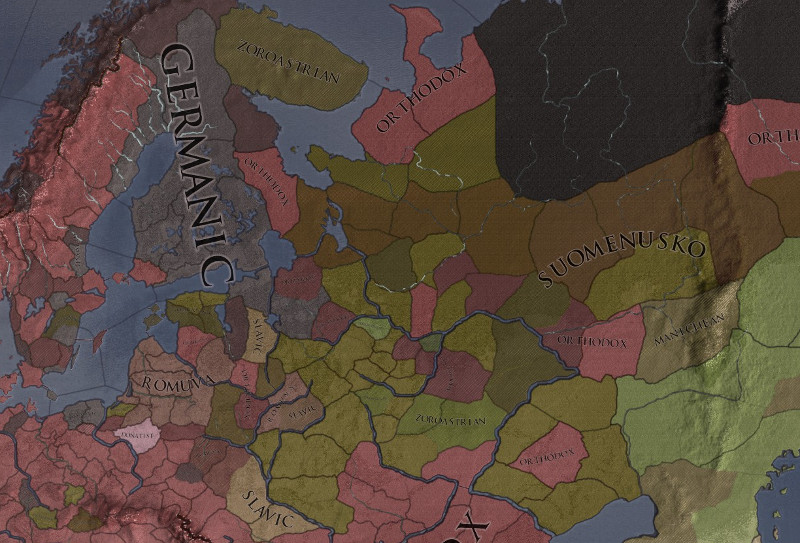 Pagans had a rough time in the 11th century. Most of the former pagan powers of Europe converted, although there remained some minor holdouts. Their last major preserve was in the east, between the Baltic Sea and the Volga River. There, countless petty chiefdoms and realms all vied for power, and all failed in their efforts. Even when pressed on all sides by growing Christian realms, no pagan realm managed to provide the leadership needed to ensure the survive of paganism in Eastern Europe. The best candidate in the circumstances, Volga Bulgaria, had a large Christian bloc within it, led by the Orthodox Duke of Mari, which hobbled its ability to fight Christians beyond its borders. 11th century Europe was overwhelmed by enormous pressures, and changed significantly in response to them. More clearly separated into Imperial Christian Roman and Pagan Feudal realms before this time, the 11th century saw Europe as a whole succumb to Roman religious pressures and Christianize, while pressures within and without caused the Carthagennan Empire to feudalize itself, and as a result feudalize much of Western Europe. In some ways, Europe became far more homogeneous- but this merely meant that Europe as a whole began to look outward, to find new outlets for aggression, new avenues to power, new wars to fight. Religions in 1091, organized by size: 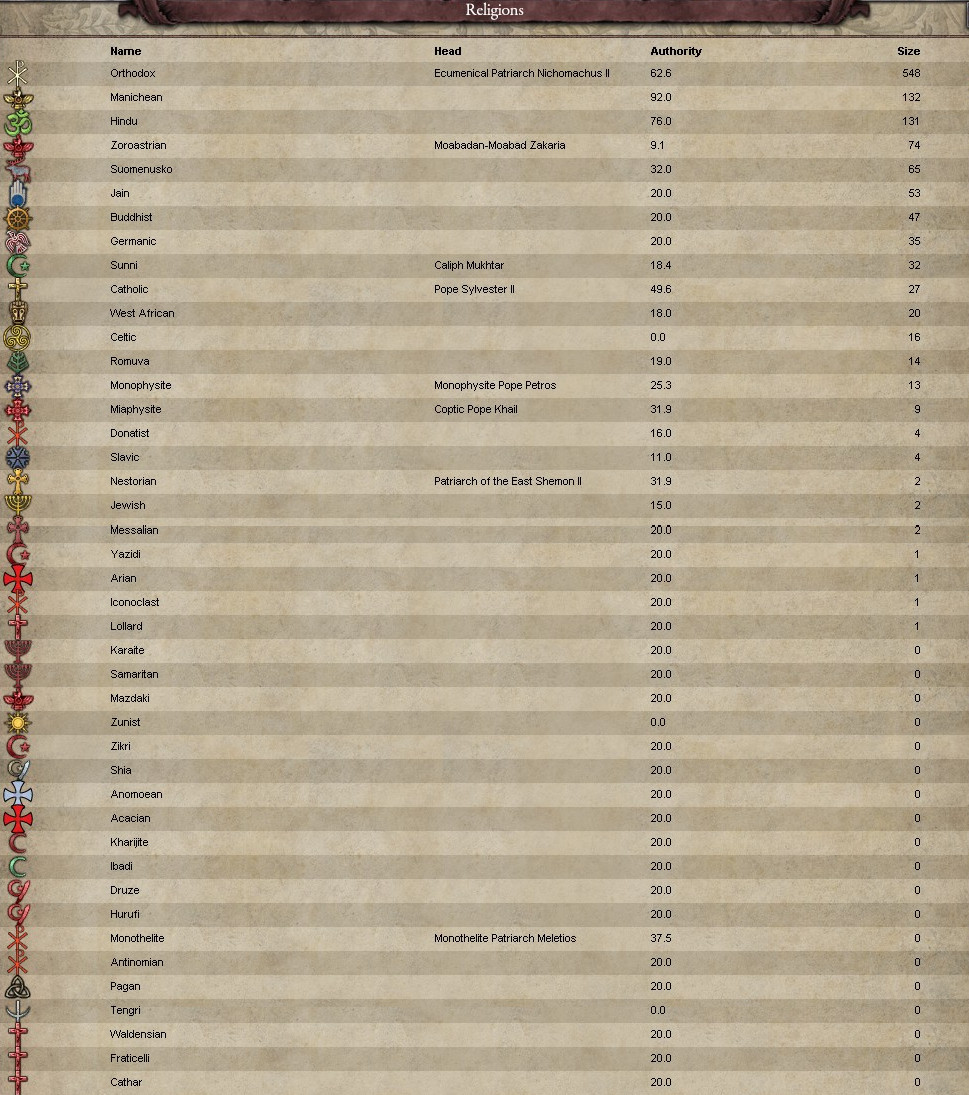 The biggest realms in 1091: 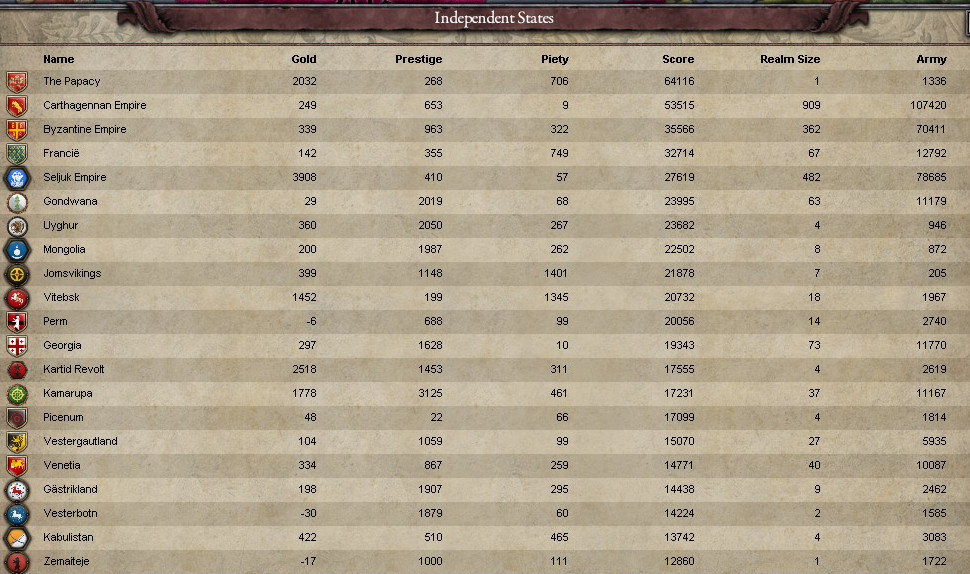
|
|
|
|
Ahh, so the letter thing is in case there's a coalition against the Seljuk? Or just fluff. Quite curious how you made the Crusades work out.
|
|
|
|
Beautiful. Deus vult.
|
|
|
|
Poor Arianism.  By the by, Ofaloaf, could we see a culture map?
|
|
|
|
I guess it's fitting that one of the most politically interesting CK2 threads would be religiously dull. That wall to wall Orthodoxy  I mean okay the gigantic Manichean Empire is a LITTLE weird I guess. Also say what you will about the Hedayatid's, their administrative capabilities and communication lines are clearly amazing.
|
|
|
|
How big is the kingdom of Pontus that the Seljuks are invading? And are the Byzantines having trouble with internal dissent as well as you say? If they lose this war and a lot of territory we may see a catastrophic collapse in Byzantium if civil wars were to break out soon after. Needless to say, if this is the case, it would be best if Gothia could ensure new and effective leadership in Byzantium and effect a renewed and strong system of cooperation and correspondence between the two great imperial capitals of Lyon and Constantinople before the East can fall to the Maniche Turk. Randarkman fucked around with this message at 03:26 on Feb 2, 2016 |
|
|
|
Lord Cyrahzax posted:Poor Arianism. The Catholics as well. By the looks of things they are not long for this world. Maybe come EUIV we will get a Catholic resurgence along with the rise of Protestantism. Nice to see that Islam isn't completely dead thought.
|
|
|
|
I hope EU4/the conversion to EU4 gives Islam a boost.
|
|
|
|
GSD posted:I hope EU4/the conversion to EU4 gives Islam a boost. Why would you devote more to some minor religion that only has two countries?  This world's CK2 had Islam as a heresy of Judaism until the fourth expansion.
|
|
|
|
|
|
|
|
Wait, are those the Jomsvikings on Scotland's eastern coast?
|
|
|
|
Ikasuhito posted:The Catholics as well. By the looks of things they are not long for this world. Maybe come EUIV we will get a Catholic resurgence along with the rise of Protestantism. We must reject our decadent, weak, fragmented Christian present and return to Jupiter, that he may grant us the strength to restore the whole of the Med to us once more.
|
|
|
GSD posted:I hope EU4/the conversion to EU4 gives Islam a boost. I'd be particularly interested in an Abyssinian branch of Islam forming under the teachings of Uways. Or just Abyssinia taking a leading role in Islam in general.
|
|
|
|
|
I'm sure this timeline's version of the Protestant Reformation, whatever form that takes, will be very interesting indeed.
|
|
|
|
Lord Cyrahzax posted:Poor Arianism. Certainly! Have the map with and without haphazard labels slapped on!  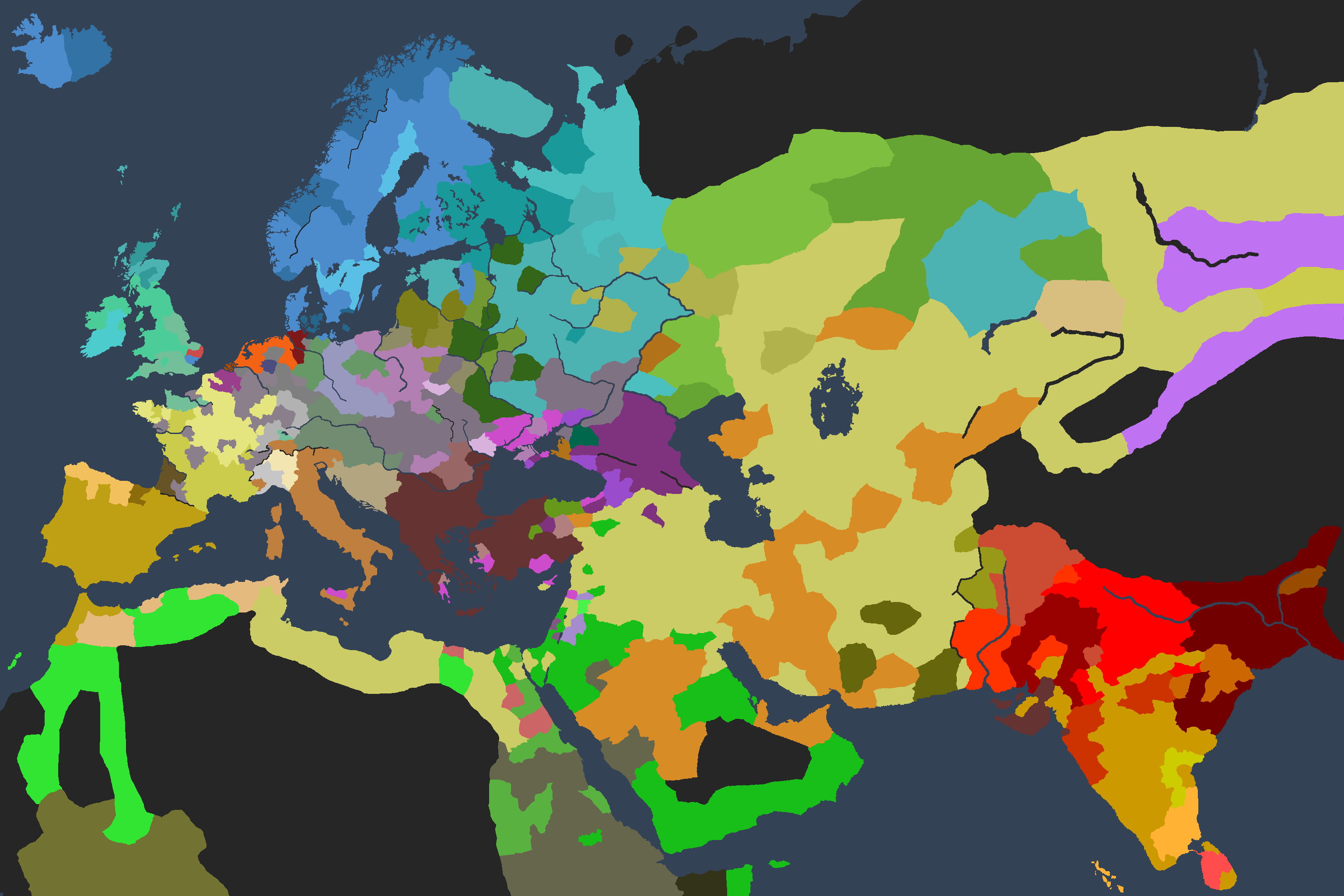 e: what a loving minute, when did mongolia become persian Lord Cyrahzax posted:Wait, are those the Jomsvikings on Scotland's eastern coast?  Also, good news! It takes only a little jiggering to get the mod and the savegame working with Conclave, so I think we're good to go there! 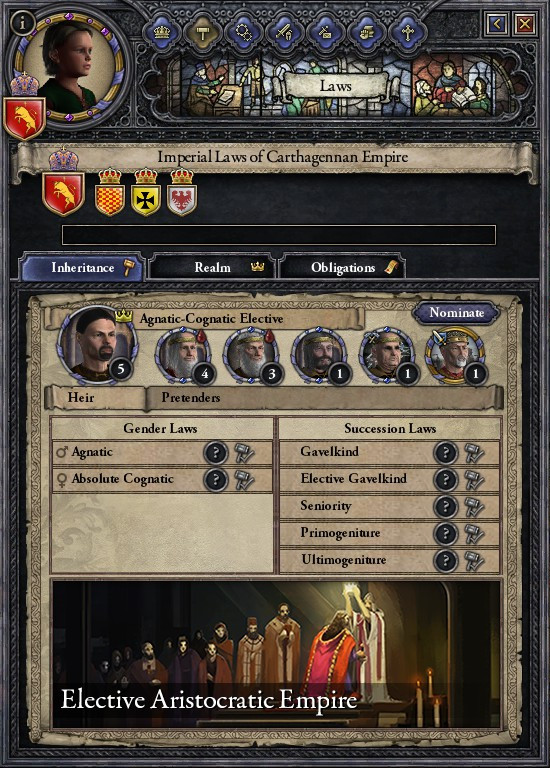 The only wonkiness I haven't worked out yet is the menu page and bookmarks, but that'll get worked out eventually probably. Ofaloaf fucked around with this message at 15:25 on Feb 2, 2016 |
|
|
|
 Great Armenia Great Armenia
|
|
|
|
What is a Traki?
|
|
|
|
Kanthulhu posted:What is a Traki?
|
|
|
|
Wow, there's still quite a few Greek provinces still hanging around in the Mediterranean and Black Sea.
|
|
|
|
Kanthulhu posted:What is a Traki? Slavic Byzantines. See this post in this vote for further notes.
|
|
|
|
You said you were only going to use the culture and religion map from CK2 as a guideline when converting to EU4 right? Because otherwise it will be loving atrocious. e: Good news on the Conclave front. I've been trying it out a bit today and the new stuff is actually pretty cool. e2: Also very timely, since the Carthagennan empire is more decentralized and dominated by the aristocracy than ever before which will fit great with Conclave. Randarkman fucked around with this message at 19:15 on Feb 2, 2016 |
|
|
|
GSD posted:
You mean Armenian Georgia.
|
|
|
|
I'm a lil' sad my loveable Zoros are now a heresy.
|
|
|
|
Hitlers Gay Secret posted:You mean Armenian Georgia. e: nevermind you meant the country in the game. Randarkman fucked around with this message at 20:29 on Feb 2, 2016 |
|
|
|
Manichaeanism should really be distinct from Zoroastrianism
|
|
|
|
Raserys posted:Manichaeanism should really be distinct from Zoroastrianism I don't know, there's probably been some significant blending of the two at this point, enough that whatever Manichaeanism Seljuk came out of the steppes with has been co-opted and reinterpreted into something that's not quite Zoroastrian, but pretty close.
|
|
|
|
Raserys posted:Manichaeanism should really be distinct from Zoroastrianism
|
|
|
|
CK2+ has a non-heresy Manichaeism, you could ask for permission to use that (I have no idea what its heresy is though).
|
|
|
|

|
| # ? May 25, 2024 01:17 |
|
A chance exists to stamp out Anglo-Saxon culture completely. What a wonderful world this is.
|
|
|








